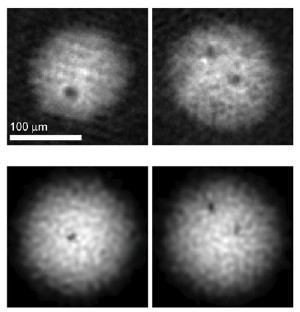Oct 16 2008
University of Arizona scientists experimenting with some of the coldest gases in the universe have discovered that when atoms in the gas get cold enough, they can spontaneously spin up into what might be described as quantum mechanical twisters or hurricanes.
 Vortices spontaneously appear during the formation of a BEC. The top row shows photographs from two runs of the experiment, where a new BEC was created in each run. The images of the bottom row show the results of two simulations. (UA College of Optical Sciences/Brian P. Anderson)
Vortices spontaneously appear during the formation of a BEC. The top row shows photographs from two runs of the experiment, where a new BEC was created in each run. The images of the bottom row show the results of two simulations. (UA College of Optical Sciences/Brian P. Anderson)
The surprising experimental results agree with independent numerical simulations produced by collaborating scientists at the University of Queensland in Australia. The Arizona and Queensland researchers are reporting the results of the research in the Oct. 16 issue of the journal Nature.
The results are of great interest because they reveal something fundamentally new about certain kinds of "phase transitions," and nature is replete with phase transitions.
Common phase transitions include liquid water freezing to ice, or liquid water boiling to steam. Another common phase transition occurs in proteins when raw eggs are cooked. More exotic examples of phase transitions include the cooling of materials until they become superconductors, and, on the scale of the universe, the phase transition that transformed the early universe from a hot, dense system born from the Big Bang into the universe with protons, electrons, structure and forces observed today.
A group of UA scientists headed by optical sciences associate professor Brian P. Anderson uses lasers and magnetic fields to trap gases of rubidium atoms and cool them to temperatures of about 50 billionths of a degree Kelvin, which is close to minus 460 degrees Fahrenheit. This temperature is about as close as scientists have ever been to reaching absolute zero, the hypothetical temperature at which all molecular activity ceases.
By first creating such a cold gas in their UA campus laboratory, and then lowering the temperature of the system just a little bit more, some atoms in the gas still behave much as they do in classical physics, bouncing around at random. However, this additional cooling induces a phase transition where other atoms of the gas become a new form of matter called a Bose-Einstein condensate, a tiny droplet of superfluid that behaves according to quantum physics.
Bose-Einstein condensates, or BECs, were first produced in Nobel Prize-winning experiments in 1995. Since then, theoretical and experimental researchers have studied BECs intensely, using BECs as valuable new tools for probing a wide range of fundamental physics. The UA experimental team, and the University of Queensland theoretical team headed by physicist Matthew Davis, paired up to push the limits of what is known about how BECs actually form.
"Scientists understand a lot more about BECs after over 10 years of work, but there are still some great surprises," said Anderson.
Their work lends additional support to the idea that spontaneous "topological defect" formation in phase transitions is a widespread phenomenon, even at temperatures near absolute zero. "Defect" in this sense means that a discontinuity has appeared in the background superfluid of the BEC.
"In our experiments, we found that when we cool an already very cold gas through the BEC phase transition, the BEC can spontaneously begin to rotate, creating something like a microscopic quantum mechanical hurricane where atoms rotate as a fluid around a vortex core where there is no fluid," Anderson said.
"The idea of spontaneous formation of vortices in BECs had been lightly discussed as theoretically possible before, but had not been observed in experiments," he added.
Ironically, showing that BECs could be spun up into a rotating state to form vortices was a hot research topic just a few years ago. Anderson was a postdoc on the team that was the first to create a vortex in a BEC. They used creative but relatively difficult techniques. Other groups have now used a variety of techniques to successfully create BECs with many vortices.
"What was so surprising about our work is that we saw these things just appear by themselves. You just make your condensate, and they sometimes appear. You don't have to somehow manipulate your system, all you have to do is cool through the phase transition."
"I think what we've done, for the first time, is link experimental observations of defect formation in a phase transition with a theoretical model and numerical simulations that are built on some pretty rigid foundations of quantum mechanics," Anderson said.
"By collaborating with our colleagues in Australia, who are doing the theoretical research, we can back out details of the physical process that causes these vortices to spontaneously form. It will help us understand more about how superfluids develop, and perhaps more about universal phase transition dynamics in general, including the kind of phase transition that occurred in the early universe."
The experimental research was supported by grants from the National Science Foundation and the Army Research Office. The theoretical work was supported by the Australian Research Council and the University of Queensland.